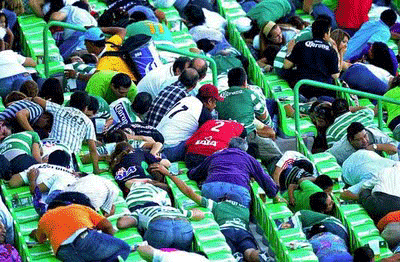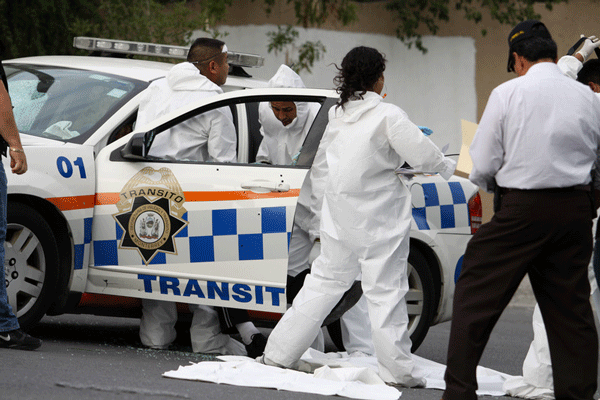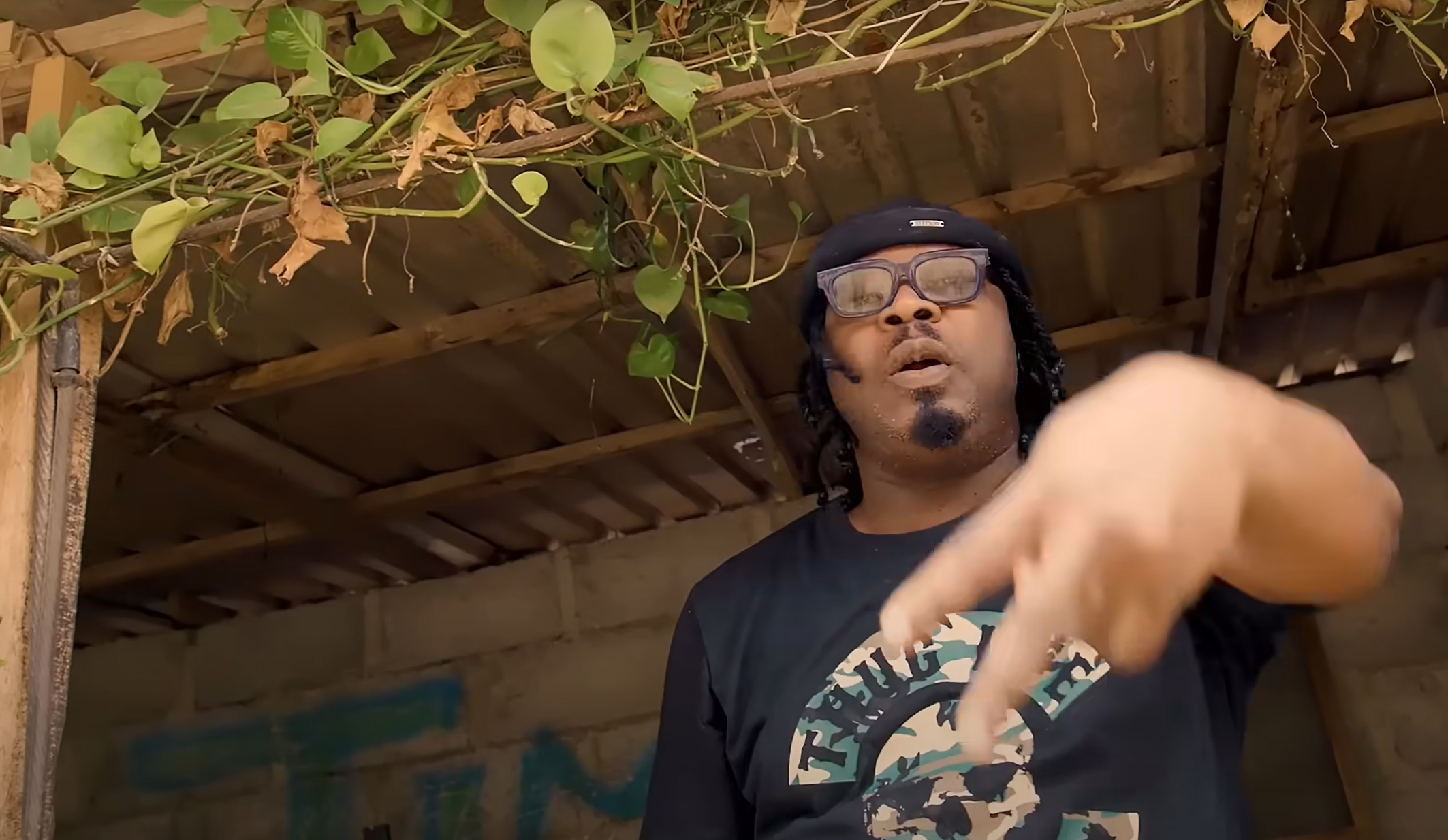In Mexico drug cartels continue to dictate news agenda and in some areas, have even infiltrated the newsroom. A new investigation by Fundacion MEPI reveals the extent to which news outlets fear of cartel retaliation and a shortage of accurate government information keep the public in the dark
MEXICO CITY – It was 38 minutes into the First Division football match at the Santos Modelo Stadium, about 275 miles from the US border, when players suddenly started running from the pitch to their locker rooms. Popping sounds interrupted the announcers. More than one million Mexican television viewers watched as a firefight between the country’s most ruthless drug cartel and local police unfolded.

August 21: Fans seek safety during gunfight outside Santos Modelo Stadium
The images broadcast from the industrial town of Torreon showed terrified men, women and children crouching under the stadium seats and scrambling for cover. Television Azteca, the second largest Mexican network, stopped transmission of the game. But ESPN continued, breaking its audience records worldwide for a domestic soccer match.
It was the first time drug-related violence had played out on live television alongside the country’s beloved national sport. But it also highlighted another battle, one raging inside the local Mexican media as criminal groups have continue to muzzle regional reporting on drug violence — savagery that has left more than 60,000 dead since outgoing President Felipe Calderon took office in December 2006.
Despite the stadium gun battle’s obvious news value, in the newsroom of the local daily El Siglo de Torreon, editors and reporters pondered whether to publish news of the shootout in a prominent place in the following day’s paper. The attack had pitted the Zetas organised crime group against a municipal police contingent parked near the stadium.
“The pictures were provocative,” says the newspaper’s top editor Javier Garza. The staff worried they might become a target if they featured the images prominently. Assailants have bombed and sprayed the newspaper’s offices with bullets twice since 2009. Journalists receive death threats and warnings from criminal groups that don’t like El Siglo’s coverage.
Mexico was the most dangerous country to be a reporter in 2011, according to the International Press Institute. Ten journalists were killed here last year and the trend continues into 2012. A well-founded fear of retaliation from organised crime has deepened an atmosphere of self-censorship among Mexico’s regional news outlets.
In a six-month investigation, a follow-up to a study in 2010, Fundacion MEPI examined publishing trends in 14 of 31 Mexican states to better understand how drug violence affects news content in regional media. The states, concentrated in northern and central Mexico, are among the country’s most violent. The study found provincial newspapers increased their coverage of organised crime in 2011 by more than a 100 per cent over last year, publishing reports on 7 out of 10 organised-crime incidents in their coverage area. But only two newspapers — El Norte in Monterrey and El Informador in Guadalajara — were able to provide context to the violence, identify the victims and follow-up on crime stories.
The shootout did feature on El Siglo’s front page the day after the attack but in line with its editorial policies the paper did not explain why the gunfight happened. Editors know that criminals read their pages to see how their organisations are portrayed and are careful not to provoke them. El Siglo’s problems are the same as those faced by regional papers across Mexico.
The Theatrics of Violence
Sadly increased coverage of drug violence in 2011 was not a sign of the threat of violence against journalist waning. Rather it reflected the news media’s response to a spike in more gruesome violence including gangland-style executions, which sociologist Eduardo Guerrero estimated grew nine per cent countrywide and by more than 100 per cent in several municipalities.
“The murders in many parts of the country were spectacular in size and dimension,” adds Alejandro Hope, a former intelligence analyst with the Mexican civilian intelligence CISEN. During an interview with MEPI in Mexico City last month he says: “There was no way the local media could ignore them.”
Some of high-profile 2011 incidents were: a fire set by Zeta operatives in the Casino Royale, a middle class gambling venue which killed 52 people; 35 nude bodies left on a main thoroughfare in in the southern state of Veracruz, and in Guadalajara, Mexico’s second largest city, 28 bodies stuffed into a parked SUV abandoned on a busy avenue.
Government Reports
Regional editors and reporters told MEPI that fear is not the only cause for spotty and weak news coverage.
A key factor is the limited flow of public information. In the stadium shootout case, local authorities failed to provide reporters with a proper police report, and according to El Siglo’s own safety protocols, reporters should not investigate such stories beyond the simplest official facts.
“It has been an uphill battle to try to get precise data from the local authorities,” Garza says. For instance, he noted, the prosecutors count homicides differently than the local police department. “Sometimes we get information from three government agencies, and they all contradict each other.”
Without this information from federal and local authorities, the regional news media cannot add context to their reporting, says Garza.
But there is yet another side of the story.
El Siglo’s patch, Torreon, is at the centre of a drug cartel turf war. Many other Mexican states face the same issues, their media are caught in the middle of cartel crossfire. In most of these states, the fear of retaliation combined with a lack of credible official information give rise to lopsided reporting dominated by coverage of beheadings, kidnappings and other criminal activities.
At El Siglo the coverage of government anti-crime efforts versus cartel-related crimes was heavily tilted towards cartel crimes. MEPI found 457 government operations described in the newspaper, far fewer than the 713 organised crime incidents El Siglo covered in 2011.
Ironically, the media in states controlled largely by one cartel tend to publish more stories about government anti-crime initiatives such police arrests and raids rather than the executions, kidnappings, home invasions, shootouts, attacks on police, government offices and personal that are the hallmarks of the cartels.

Forensic officers investigate murders of traffic police in Monterrey – 11/07/2012
In the Zeta controlled states of Tamaulipas, Michoacan and Zacatecas the media shied away from writing about drug organisations and their activities.
In Tamaulipas, which the MEPI study found suffered the highest rate of self-censorship, the newspaper El Mañana rarely covered organised crime violence. The few cartel stories it reported happened in Texas.
“In Tamaulipas the press is often co-opted,” says Carlos Flores, a security expert, and author of a book on the ties between local authorities and organised crime in Tamaulipas. Flores believes many journalists are concerned about cases of cartel spies infiltrating the newsrooms.
In Michoacan, another state where the study revealed organised crime reporting was limited, it is widely accepted that the cartel, La Familia, and its splinter group, the Knights Templars, are in control of criminal activities. Yet the newspaper monitored, La Voz de Michoacan, never mentions cartel names.
Not an Easy Fix
In some cities, official reporting has improved somewhat with the help of civil society and private sector initiatives. In both Ciudad Juarez and Monterrey, new private-public initiatives increased the flow of statistics. Alfredo Quijano, editor of the daily Norte, pointed to the creation two years ago of the Mesa de Seguridad, or Roundtable on Security, a civil society and government entity that gathers crime information and promotes public participation. And in Monterrey, the Consejo Civico de Instituciones de Nuevo Leon, or Civic Council of Institutions of Nuevo Leon, a private sector advocacy group that pushes for transparency in government affairs.
The lack of accountability and information flow goes back to Mexico’s history of a political system dominated by one party — Institutional Revolutionary Party (PRI) — Flores says.
For many years the authorities were not there to inform the public, but to release information that was useful to the government.
Getting the various government entities to release credible information will remain difficult, according to security experts familiar with government reporting in Mexico.
Local governments officials often do not have accurate intelligence about what is going on in their regions, says Leticia Ramirez de Alba, who coordinates studies on criminal trends for the non-governmental organisation Mexico Evalua.
Many often lack basic investigative skills while others are in collusion with organised crime, she says. In the last six years dozens of top government officials and police have been identified by Mexican intelligence as working for various organised crime groups. A recent case involved the arrest of 14 federal police officers who detained in connection with the attempted murder last August of two CIA contract officers and a Mexican Navy captain in a remote road near Mexico City. US officials suspect organised crime links, according to press accounts.
Meanwhile, statistics became an important measure of Mexico’s anti-crime programmes. In 2010, President Felipe Calderon, under pressure from human rights groups, released the first online database of organised crime-related homicides, dating back to 2006. For the first time there were official government numbers on the toll of rising drug-related violence. But the online database was criticised for lax sourcing. As the database was national, it also raised a legal question over whether the responsibility to investigate these murders lay with state-level, or federal authorities.
In 2011, the Attorney General’s office released another set of statistics, but it only covered homicides from January to September. It is unclear whether incoming President, Enrique Peña Nieto, of the PRI, which ruled the country for 70 years, will continue to provide statistics on crime.
Meantime, every state is ostensibly required to give the federal government credible figures on its crime trends. But local and state authorities have being caught manipulating the numbers to make their state look safe and appealing to voters. The practice is very common, according to Mexico Evalua.
According to El Siglo, in 2011, officials in Torreon faked crime figures, erasing more than 100 killings from the official docket. In 2007, the government of Mexico state, which borders Mexico City, also manipulated its numbers, reducing its violent homicide rate by 60 per cent, says Ramirez de Alba. The errors were made while President Elect Peña Nieto was governor of that state.
No Watchdog Journalism in Mexico
Marco Lara Klahr, a journalist and media trainer, has his own theory about why Mexican journalist shy away from digging deeper:
Journalists are not being trained to report on stories that go beyond the violence and which describe endemic problems with Mexican justice and political systems…As journalists, we are not doing our job of watchdog journalism.
In Torreon, El Siglo editor Garza says his editors and reporters understand there is a need to find better, safer ways to report on the drug war but for now they are doing the best they can.
In March 2011, 715 newspapers, radio and television stations attempted to improve crime coverage, signing an agreement to promote fair coverage. The final document included a statement obligating news media “to present information with exact context that explains the real problem of violence in the country.” The accord also required journalists to make sure “crime-news stories specify who provoked and carried out the violent act.” El Siglo signed up.
Garza says he knows the newspaper’s limitations and is searching for better ways to practice strong journalism while under constant threat. He is now encouraging his editors to build databases and use crime statistics in charts and maps that quantify the scope of the state’s problems.
He remains hopeful, saying: “We think it might be the way to avoid security threats in the future.”
Ana Arana And Daniela Guazo, Fundacion Mepi. Ana Arana is also Index’s Mexican correspondent
This report was based on research supported in part by Index on Censorship & the Doen Foundation




